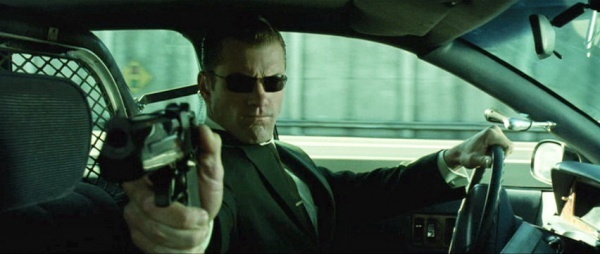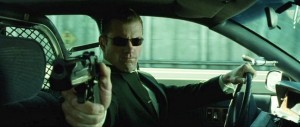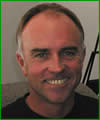
 Archival interview with R.A. Rondell from the official Matrix website.
Archival interview with R.A. Rondell from the official Matrix website.
MATRIX: What other projects have you worked on?
R.A. RONDELL: I just finished Exit Wounds a couple of days ago, with Steven Seagal out of Toronto. Last summer I did The Patriot, I’ve done Waterworld, Dante’s Peak, Godzilla, numerous other motion pictures, and I did a lot of television fourteen, fifteen years. I started when I was about seventeen years old, my father is still a working stunt man, stunt coordinator, as are members of my family, brothers, cousins, uncles. My grandfather started in the thirties working with the Keystone Cops, he actually retired in 1965 with the First Assistant Director, so it’s basically been our life.
MATRIX: So you grew up around film sets?
R.A. RONDELL: I was a stage brat, set brat.
MATRIX: You said you got into the business when you were 17?
R.A. RONDELL: Yes, I was still in high school. I didn’t really want to work at the time in the motion picture business proper, I was just skiing and surfing and making enough money doing odd jobs to go do those things. Then a good friend of mine called and asked me to double Jan-Michael Vincent on a picture called Baby Blue Marine. I was a good swimmer so I went up and swam the McLeod River. I started working continuously as soon as I got out of high school, that was at 18, and at 19 I coordinated my first film called Fast Charlie, The Moonbeam Rider with David Carradine, which was a full period motorcycle picture. I come from a large motorcycle background of racing, I went out as a kid with my father, so I just jumped right into it from there. I started to do a lot of television because action television was at its height in the early eighties. I started directing second units and then television went away for a while and the features started getting bigger. I jumped into the feature department where my first big break was Waterworld, something with a lot of scope, and that brought me up to the A list of A films.
 MATRIX: What is your take on your slice of the effects?
MATRIX: What is your take on your slice of the effects?
R.A. RONDELL: As the Stunt Coordinator, basically I get the script, I talk with the Directors, and try to perceive what they want to see. Then it’s kind of a producing aspect: I need to get all the right talent involved, people who can double your actors that are the right size and have the right capabilities and expertise, then try and design the sequences for them and put it together with the other departments. If I need cars or whatnot, I speak to the Transportation Department; if I need to rig the cars to do something like flip, that goes to Special Effects; to see how different rigs work, I work with the Camera Department; I work with the Grip Department as far as rigs to hold the cameras for different positions; locations to find the right spot to shoot it in; wardrobe, etc, etc. So we work hand in hand with all of the departments and try to put everything together in a safe and exciting fashion and make it work for them.
MATRIX: The film is still in pre-production, where are you in the process right now?
R.A. RONDELL: Going through the storyboards initially is just amazing. It’s a huge undertaking, there will probably be one of the biggest car chases ever filmed, which is the project they’ve given me to do. The use of pre-visualization, as far as letting the computer animate the car chases for us ahead of time, is going to be a tremendous tool. In the sense that they’re setting speeds for me, or I’m bouncing back and forth telling them what realistically I can shoot, cars and traffic patterns, what the speeds would be at to be overtaken by chase vehicles and achieve what they want to see going in and out of traffic. They’re allowing me to see that ahead of time with virtual cars, and I can make a determination of what we can do real time and what we can’t.
At the same time, they’re going to be able to take some of the cars out that are going to become just a little bit too dicey to really negotiate safely, and still make the same moves, and they’ll put those cars in there just that much tighter for me. It’s pretty cool; it’s a nice tool. I’m really excited as well, because I’m getting to see it put together ahead of time, and then they’re going to print it off and I’ll have a play book.
So when I go to the set I don’t just sit down with my little cars and tell all the guys where everything lines out, I can actually give them a play book right off the bat – say this is your car, you’re travelling this amount of feet, this many miles an hour, I need this action to happen here, down to feet – eight feet a second at sixty miles an hour, it’s very, very calculated, and it’s cool. I can see it at 20, 30, 40 miles an hour, whatever speed I want to determine. I can have them show me on the computer, and right off the bat find out what is realistic, what’s not, how far over pushing the envelope Larry and Andy want to go. I can get them to the extreme that I can take it physically, then they can take it just a bit beyond with the computer.
MATRIX: Have you had the opportunity to work with a pre-viz dept before?
R.A. RONDELL: Yes, but not in a car aspect. I’ve had them put some things together for me with climbing and flying around on top of a tower, where there’s some crane work with people flying around just to kind of give the studio an idea with where we were going. We put together an action beat scenario for the studio for the script I was working on before this. They were having a hard time visualizing what we wanted to do, so we put together a pre-viz so they could actually see all the movements and how everything was going to work, well before camera positions or anything, to give an overall view of what we were going to do. Then for whatever reason that idea went away.
What we are working on at THE MATRIX is something they absolutely want to do, and now it’s at more of a planning stage; it’s not just to say, okay yeah, this is going to look great, or whether we want to do it or not. They want to do it, and now it’s down to feet and seconds and miles per hour, amounts of cars, colors of cars, positioning, and how the cars perform.
MATRIX: What was your reaction on seeing the first film?
R.A. RONDELL: It is still a visual delight to me, I’ve watched it many, many times. It was so far ahead of its time and it has become what everyone is trying to achieve now in some form. From visually, in the Special Effects, to Hong Kong kung fu theatre fighting styles and things that are going on. Everybody is trying to imitate pieces of it all along and it’s nice that this one is even going a step beyond that – and some – I’m very happy to be part of it.
MATRIX: Does it feel, considering that so much has been appropriated for other productions, a daunting challenge to coordinate the stunts?
R.A. RONDELL: Oh yeah, this is a huge challenge, I welcome it.
The brothers have a tremendous vision, they are so specific about what they want. Usually you’re trying to draw from people: What do you really want to see here? How do you want to do it? And you’re trying to feed them information just to get them to make a decision. These guys know what they want right up front, board for board, frame for frame. You’re trying to achieve what they want and then give them ways you can make it happen for them, or be straight up front with them saying, “No, I can’t do that physically, but here’s what I can give you,” and they make those decisions. It’s a breath of fresh air.
MATRIX: So this enables you to take the stunts farther?
R.A. RONDELL: Yeah, it’s going to be huge.
MATRIX: Talk about your sense of the production; how much bigger is it that the first one?
R. A. RONDELL: It’s different. I’m dealing more with the freeway scenario right now and the scope is bigger than any car chase I’ve ever seen. In actual fact, when I met with Larry and Andy the first time, they asked me what was the best car chase that I had ever seen, I told them it hadn’t been shot yet, and they looked at me. I said, “Yeah, we could talk about all kinds of French Connection, we can talk about Ronin, we can talk about all sorts of different things, but you can only take pieces from them. They were all kind of great, or they had pieces that were great, but none of them were entirely perfect.” This has the possibilities of being the biggest and the best car chase ever filmed, there are so many good people on the team, all the teams together, everybody has the same impression and I think everybody is going to give their best to give them that.
MATRIX: What preparation are your people doing for the car chase?
R. A. RONDELL: We’re not actually doing any training for it yet, and we probably won’t do much. The people who come and work for me are fully trained professional drivers, but I have sent Carrie-Anne Moss to driving school. I sent her out to Rick Seaman’s Driving School where she did stunt performing for a couple of days. She learned how to do 90s, 180s, all kinds of stuff, sliding around cones, simulating all kinds of things, being chased by a car, chasing a car, pacing off another car like it was an insert car. I’m going to use her as much as possible, like all the actors. Right now it’s kind of an area where I try and find out, where everybody’s limitations are, what their expertise are, and what their weak points are. This means we can use them to the height of their expertise, and at a safe level, and not put them in a position where they are vulnerable or fall short. If you can find out what those are up front, then you can set your sequence to totally capitalize on what they’re good at. I’m also going to go out with Carrie-Anne to ride on motorcycles, because there is some motorcycle work in the picture as well.
The rest of the cast is in fight training right now, which is extensive. Wo Ping is in charge of all that and it is amazing, they are working out real hard. I’m going to take them out as well and take them to the driving school; although they don’t drive in the picture, they will ride passenger in the picture, and I want them to get a sense of what it feels like to be in a high speed chase. So they’ll go with stunt drivers out to the school and do full simulated chases, to get a sense of it right off the bat, then it’s not a fear factor, it becomes an acting thing.
When I get them out there and they’re riding in the insert car, whatever it is, it’s not “Oh my God! Am I in a safe spot?”, it’s all about doing what they are supposed to be doing. Laurence’s character is never scared, he’s always solid, I don’t ever want him to be doing the white knuckle on the dash because something is happening; he’s already been there, and now he knows he’s in a safe spot, it’s all about acting. Whoever they may be it will be the same thing – everybody will get a chance to go for a ride well ahead of time. When you get the confidence level up you get a better performance out of everybody.
MATRIX: Have you had the opportunity to read the scripts?
R.A. RONDELL: Just two.
MATRIX: Do you feel that Larry and Andy are pushing the envelope further than the first film?
R.A. RONDELL: I don’t know about pushing the envelope in that area – when I say pushing the envelope, I think of it in a stunt sense. Script wise, what’s the envelope? You can go on and on forever, and as long as you can keep the audience interested, we’ll believe anything. The sequences are huge, but with the use of computers and things available in visual effects now, we can make everything to a point of being very, very controlled… but still dangerous, it’s all part of the deal. We make choices in what we’re doing here and everything is controlled, there are times when it gets a little dicey, but they’re giving us the chance to push it to those areas. With the use of the computer and being able to erase cables and do things like that, it gets us to a point where we can be very, very safe and go beyond it. There are things I wouldn’t try physically without some kind of a safety net.
MATRIX: In your years as a stunt person and coordinator, have you ever worked with wires before?
R.A. RONDELL: Yes, wire work has been around for 20 years, to an extent. Big cable or little cable, you’d always have to hide it or the rope or other apparatus. Now you’re pretty much allowed to show it, and they’re just going to take it away. Of course the Visual Effects Department will always ask me to try and keep it to a minimum, and that’s acceptable of course, but they don’t restrict you from using it.
MATRIX: In recent years visual effects have changed dramatically. How has that affected the way you do and approach a film?
R.A. RONDELL: There are no rules, there are no boundaries. If you can think it up, dream it up, they can pretty much put it together for you. It scares me in a sense, I don’t think it’s going to happen in my career time, but it won’t be long before they don’t need stunt people anymore. It’s a fact. Maybe we’ll be needed to help them design how sequences go together, maybe to show how body movement works, but it’s very, very scary. I’ve seen pieces put together for me as presentations on other films, where they just wanted to show me how the person was supposed to react to whatever apparatus I was going to put together with them, and if it wasn’t for the blank face that wasn’t there, it was a person. So that frightens me. Again, I don’t think it’s going to happen in my career or lifetime, but it’s soon. We’ll just carry on and do the best we can, they’ll always need us for something.
MATRIX: What are your expectations for THE MATRIX 2 and 3?
R.A. RONDELL: I’m sure they’re going to be a huge success, no doubt about that. Again, I haven’t read the third script, I can only imagine it is as good as two or better. One was great, a visual delight, two is outstanding. With this car chase, I believe the audience will be thoroughly exhausted by the time it’s over, and they haven’t even gone through most of the film, it’s just got started. They’ll be panting and dragging themselves out of the theatre. That’s what we’re here for, to keep them on the edge of their seats the entire time, completely dazzled and overwhelmed.
MATRIX: Thanks R.A.
Interview by REDPILL
November 2000

Be the first to comment